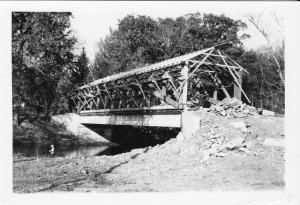40th anniversary of the covered bridge relocation
 This year marks the 40th anniversary of the iconic covered bridge that spans the Yellow Breeches Creek. Ken Mark ’72, now director of the Oakes Museum at Messiah College, was one of two work-study students who assisted with the disassembling, relocating and reconstructing the covered bridge from Bowmansdale, two and a half miles away, to Messiah.
This year marks the 40th anniversary of the iconic covered bridge that spans the Yellow Breeches Creek. Ken Mark ’72, now director of the Oakes Museum at Messiah College, was one of two work-study students who assisted with the disassembling, relocating and reconstructing the covered bridge from Bowmansdale, two and a half miles away, to Messiah.
Prior to its relocation, the bridge had fallen into severe disrepair. According to Mark, “The macadam road surface had developed potholes such that you could see straight down to the creek underneath.” Likewise, the original cedar shingles on the roof had been replaced with tin which was also deteriorating rapidly and starting to affect the wood beams underneath. Overall Mark remembered, “The bridge was ugly.”
After being randomly selected for the project, Mark, an elementary education major with a history minor, was overjoyed to know that such an important piece of history was going to be restored and preserved at Messiah College. After purchasing the bridge and finalizing the legal papers, the deconstruction process began in early spring of 1971. Almost immediately, challenges arose with the project. For starters, the equipment leased to the project was in poor condition. In Mark’s words, the crane was “almost an antique.” At the same time, PPL had recently strung a new wire near where the crane was sitting. This created a severe risk of electrocution made worse by the fact that two of the workers had to stand in the middle of the creek to catch any falling debris to keep the water clear. The workers also had to contend with the abundance of black snakes that lived in the area. While the snakes were not deadly, “seeing eight or 12 swimming around was a little unnerving,” recalled Mark.
 Once deconstruction was complete, it was determined that only about 50 percent of the original structure could be saved. This included the long arching beams that can be seen on the inside of the bridge today, the upright supports for the roof and about half of the original pins that held the bridge together.
Once deconstruction was complete, it was determined that only about 50 percent of the original structure could be saved. This included the long arching beams that can be seen on the inside of the bridge today, the upright supports for the roof and about half of the original pins that held the bridge together.
Eventually, the entire maintenance department of the College joined in to help with pouring and setting the cement abutments needed to support the bridge at its new location. The work was soon completed and the reconstruction of the bridge continued. New I-beams were bought from a local steel yard to support the bridge’s length, and the pieces were reassembled with great care to avoid damage to the original parts.
Mark remembered one of the scariest parts of this process being the rebuilding of the roof. In order to do this, the workers had to walk along the upper support beams without any safety harnesses. Looking down was potentially deadly since the river flowed perpendicular to the direction they were moving and could easily throw someone off balance. On some days “it was all but impossible to muster the courage to go up and walk across,” Mark remembered. Thankfully, nobody was ever hurt, and the roofing was finished with new cedar shingles in the original style of the bridge.
The bridge held its grand opening at Homecoming in 1972 and has since become one of the iconic images associated with Messiah College. Mark expressed satisfaction at the recent refurbishment of the bridge in September 2011 because it assures him that it will continue to be a historical icon for many years to come.
Story by Jeremy Ross ‘16. Photograph of Ken Mark by Megan Dobinson `16.




